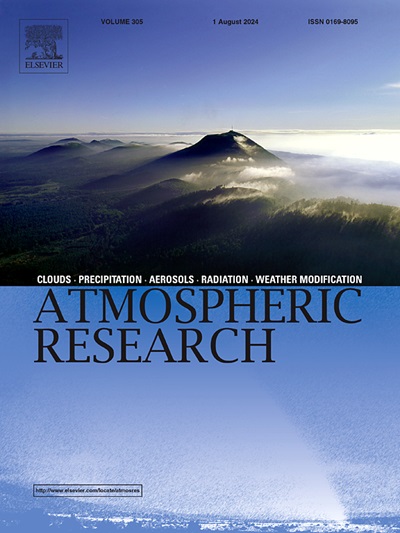Analysis of gradient wind balance during the rapid intensification of Hurricane Wilma (2005)
IF 4.5
2区 地球科学
Q1 METEOROLOGY & ATMOSPHERIC SCIENCES
引用次数: 0
Abstract
Understanding the rapid intensification (RI) of Hurricane Wilma (2005) in terms of the maximum wind has been carried out in a series of papers, this study examines the gradient wind balance and imbalance during RI, based on a 72-h Wilma prediction conducted using the Weather Research Forecast Model (WRF) with the 1-km grid resolution. Results show that the pressure gradient force (PGF) near the eyewall increases rapidly during the RI period. The maximum PGF associated with the gradient wind balance is determined by the strong radial gradient of the thermal field near the eyewall, resulting from the warming in the eye and adiabatic cooling near the eyewall. The maximum PGF occurs inside the radius of the maximum wind, causing a convergence region and intense updrafts, which favors RI. In a balanced symmetric framework, the hydrostatic PGF accounts for a major fraction (70 %–90 %) of the predicted PGF, and the secondary circulation is underestimated by the Sawyer-Eliassen equation within the boundary layer, at upper levels and through the intense eyewall updrafts where gradient wind imbalance occurs. The unbalanced force accelerates the boundary-layer radial inflow that contributes to the inward contraction of the eyewall and then enhances the radially inward advection of high absolute angular momentum. The eyewall convection strengthens where the boundary-layer inflows, convergence, and heat and moisture flux are collocated. With the high inertial stability, a sufficient conversion efficiency from energy to kinematic energy favors the RI of Wilma.
威尔玛飓风(2005 年)迅速增强期间的梯度风平衡分析
已有一系列论文从最大风力的角度对飓风威尔玛(2005 年)的快速增强(RI)进行了研究,本研究基于使用 1 千米网格分辨率的气象研究预测模式(WRF)进行的 72 小时威尔玛预测,对 RI 期间的梯度风力平衡和不平衡进行了研究。结果表明,在 RI 期间,眼球附近的压力梯度力(PGF)迅速增加。与梯度风平衡相关的最大压力梯度力是由眼球附近热场的强烈径向梯度决定的,这种梯度是由眼球内的增温和眼球附近的绝热冷却造成的。最大 PGF 出现在最大风半径内,造成一个辐合区和强烈的上升气流,有利于 RI。在平衡对称框架中,静压 PGF 占预测 PGF 的主要部分(70%-90%),Sawyer-Eliassen 方程低估了边界层内、高层和发生梯度风不平衡的强烈眼球上升气流中的次级环流。不平衡力加速了边界层的径向流入,导致眼墙向内收缩,然后加强了高绝对角动量的径向向内对流。在边界层流入、辐合以及热量和水汽通量共同作用的地方,眼墙对流会加强。由于惯性稳定性高,能量到运动能量的转换效率足够高,有利于威尔玛的 RI。
本文章由计算机程序翻译,如有差异,请以英文原文为准。
求助全文
约1分钟内获得全文
求助全文
来源期刊

Atmospheric Research
地学-气象与大气科学
CiteScore
9.40
自引率
10.90%
发文量
460
审稿时长
47 days
期刊介绍:
The journal publishes scientific papers (research papers, review articles, letters and notes) dealing with the part of the atmosphere where meteorological events occur. Attention is given to all processes extending from the earth surface to the tropopause, but special emphasis continues to be devoted to the physics of clouds, mesoscale meteorology and air pollution, i.e. atmospheric aerosols; microphysical processes; cloud dynamics and thermodynamics; numerical simulation, climatology, climate change and weather modification.
 求助内容:
求助内容: 应助结果提醒方式:
应助结果提醒方式:


